Execution of SS soldiers at Dachau"The killing of unarmed POWs did not trouble many of the men in I company that day for to them the SS guards did not deserve the same protected status as enemy soldiers who have been captured after a valiant fight. To many of the men in I company, the SS were nothing more than wild, vicious animals whose role in this war was to starve, brutalize, torment, torture and murder helpless civilians." Flint Whitlock, The Rock of Anzio, From Sicily to Dachau: A history of the U.S. 45th Infantry Division 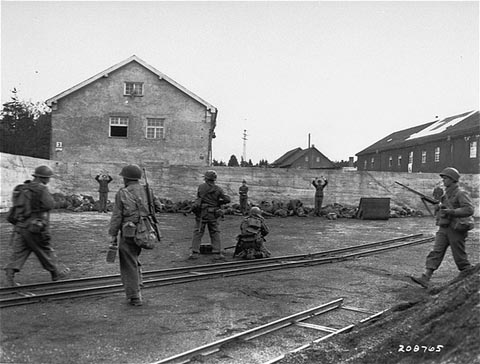 The photograph above is a still photo, taken by T/4 Arland B. Musser, 163rd Signal Photographic Company, US Seventh Army, on April 29, 1945, the day that the Dachau concentration camp was liberated. It shows 60 Waffen-SS soldiers on the ground, some wounded, some playing dead, and 17 dead, according to Flint Whitlock, historian for the 45th Thunderbird Division, who got this information from Lt. Col. Felix Sparks, commander of the 3rd Battalion, 157th Infantry Regiment, 45th Division of the US Seventh Army, the first unit to arrive at the Dachau camp. In his book entitled "Surrender of the Dachau Concentration Camp 29 April 1945," Col. John H. Linden identified the men in the photo as follows: The second American soldier from the left is Bryant, whose first name is unknown, but whose nickname was "Bird Eye." The third soldier from the left is Martin J. Sedler, and the man who is kneeling is William C. Curtain. All three of these men were with M Company of the 3rd Battalion, 157th Infantry Regiment. The soldier at the extreme right is Pfc. John Lee of I Company. The buildings in the background are inside the Dachau SS garrison where Waffen-SS troops were quartered; the building on the right is a hospital where a Reserve Company of crippled Waffen-SS soldiers, previously wounded in action, were quartered. The Waffen-SS was the elite volunteer Army which included many divisions from other countries, as well as German soldiers. According to Col. John H. Linden's account of the liberation of Dachau, T/3 Henry F. Gerzen, 163 Signal Photographic Company, was filming the shooting with a movie camera. A few frames of this movie, which survived the cover-up of the Dachau massacre, show Lt. Col. Felix Sparks firing his pistol in the air to stop the action shown in the photo above, which allegedly took place around noon. However, Col. Howard A. Buechner, a medical officer with the 45th Division, claims that the photo above shows a second incident when 346 Waffen-SS soldiers were executed on the orders of Lt. Jack Bushyhead, at around 2:45 p.m.  The photograph above shows 27-year-old Lt. Col. Felix Sparks firing a pistol into the air, while at the same time, he is holding up his left hand as a signal to the American soldiers to stop shooting. In 1989, Lt. Col. Sparks wrote an account of the role of the 45th Infantry Division in the liberation of Dachau. His description of what happened at the wall is as follows: As I watched, about fifty German troops were brought in from various directions. A machine gun squad from Company I was guarding the prisoners. After watching for a few minutes, I started for the confinement area (the concentration camp), after taking directions from one of my soldiers. After I had walked away for a short distance, I heard the machine gun guarding the prisoners open fire. I immediately ran back to the gun and kicked the gunner off the gun with my boot. I then grabbed him by the collar and said: "What the hell are you doing?" He was a young private about 19 years old (Private William C. Curtin) and was crying hysterically. His reply to me was: "Colonel, they were trying to get away." I doubt that they were, but in any event he killed about twelve of the prisoners and wounded several more. I placed a noncom on the gun and headed towards the confinement area. In his 1989 account of the liberation of Dachau, Sparks wrote the following regarding the number of SS soldiers who were killed in the Dachau massacre: It was the foregoing incident which has given rise to wild claims in various publications that most or all of the German prisoners captured at Dachau were executed. Nothing could be further from the truth, The total number of German guards killed at Dachau during that day most certainly did not exceed fifty, with thirty probably being a more accurate figure. According to Whitlock, the men of the 45th Infantry Division had been warned about the danger posed by German POWs by General George S. Patton, Jr., the Commander of the US Seventh Army, on June 27, 1943 just before their invasion of Sicily. Whitlock wrote: "Patton cautioned the men to watch out for dirty tricks when it seemed a group of enemy soldiers wanted to surrender. A favorite tactic, the general said, was for a small group to suddenly drop their weapons and raise their hands or wave a white flag. When unsuspecting Americans moved into the open to take the enemy prisoner, the 'surrendering' troops would hit the dirt and their comrades, lying in wait, would spring up and mow down the exposed Americans. Patton warned the Thunderbirds to be on their guard for this sort of treachery and to show no mercy if the Germans or Italians attempted this trick. His words would have fateful repercussions." The "fateful repercussions," that Whitlock was referring to, was the incident that happened at the liberation of Dachau when a young soldier of the 45th Infantry Division of the US Seventh Army opened fire on a group of Waffen-SS soldiers who had surrendered. He claimed that the surrendered soldiers had moved forward. As the 45th Infantry Division advanced toward Dachau, with orders to liberate the infamous Concentration Camp, where it was common knowledge that Jews were being exterminated in gas chambers by the Nazis, the American soldiers had no prior information about the existence of the SS-Übungslager, which was the equivalent of an Army post, located right next to the Dachau prison compound. The gas chambers were just outside the barbed wire fence that separated the prison compound from the SS training camp. The men of the 45th Division were not expecting to find a garrison of soldiers, much less Waffen-SS soldiers. For the Americans, the SS had a reputation as the most evil of the evil German soldiers. Part of the bad reputation of the Waffen-SS stemmed from the fact that the guards in all the Nazi concentration camps were soldiers in the infamous SS-Totenkopfverbände, or the "Death's Head" unit of the SS. The regular Germany Army was the Wehrmacht. Before reaching the SS camp, the soldiers of Lt. Col. Felix Spark's 3rd Battalion, 157th Regiment, I company, under the command of Lt. William P. Walsh, had seen a long line of abandoned cars of a freight train, filled with emaciated corpses, on Friedenstrasse (Peace Street) just outside the SS garrison. The photograph below shows the "Death Train." The train was loaded with prisoners from the Buchenwald camp, who had been evacuated to Dachau, but the train had been delayed for three weeks because of American bombing of the railroad tracks; some of the dead prisoners on the train had been killed by American bullets when the train was strafed by American planes, as Pfc. John Lee noted in his description of the liberation. The Waffen-SS soldiers, including a unit of Hungarian soldiers, who surrendered to the 45th Infantry Division in good faith, had nothing whatsoever to do with the Death Train. The photo below shows American soldiers looking at the bodies of German soldiers who were taken to the Death Train, after they had surrendered, and shot by the American liberators. 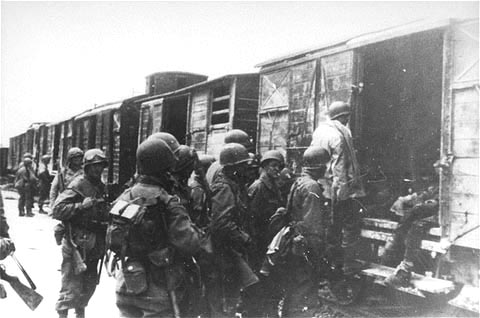 An advance party of soldiers of I Company followed the railroad tracks and entered the SS garrison through the railroad gate, some time before an advance party from the 42nd Division went directly to the southwest entrance into the Dachau complex, where an SS-Totenkopf officer, 2nd Lt. Heinrich Wicker, was waiting to surrender the Concentration Camp. As quoted in Flint Whitlock's book "The Rock of Anzio," Lt. Col. Sparks said, "We went along the south side of the camp and I saw the main entrance and decided to avoid it; if the Germans were going to defend it [the camp], I figured that's where they'd do it." According to Whitlock, "Spark's decision to avoid approaching the main gate would result in much confusion and controversy for decades to come, for inside that gate, the Germans were ready to surrender, not fight." The gate shown in the photograph below is where "the Germans were ready to surrender, not fight." It was about 75 yards from this gate, located on the southwest side of the Dachau complex, that 2nd Lt. Heinrich Wicker surrendered the Dachau concentration camp to Brig. Gen. Henning Linden of the 42nd Infantry Division. This photo was taken after the liberation; it shows two American soldiers guarding the gate. 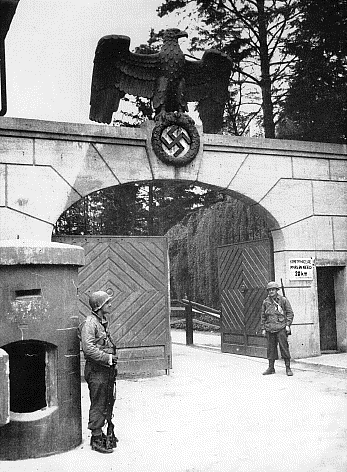 Whitlock quotes Lt. Walsh as follows: There's a big gate, and this German guy comes out of there. He must have been about six-four or six-five, and he's got beautiful blond hair. He's a handsome-looking bastard and he's got more Goddam Red Cross shields on and white flags....My first reaction is, "You son of a bitch, where in the hell were you five minutes ago before we got here, taking care of all these people? ....Well, everybody was very upset. Every guy in that company, including myself, was very upset over this thing, and then seeing this big, handsome, son of a bitch coming out with all this Red Cross shit on him. The photograph below shows the "big gate" which Lt. Walsh described. This photo was taken on the day of the liberation; it shows Waffen-SS soldiers from the garrison surrendering to the Americans. 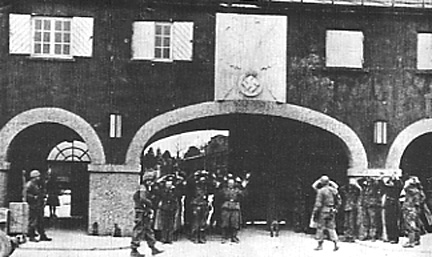 What Lt. Walsh and the men of I company did not know was that the SS training camp and garrison was completely separate from the Dachau concentration camp, although the prison compound was inside the large SS complex, and only accessible by first going through the gates into the SS garrison. The gate into the Dachau concentration camp is shown in the photograph below. 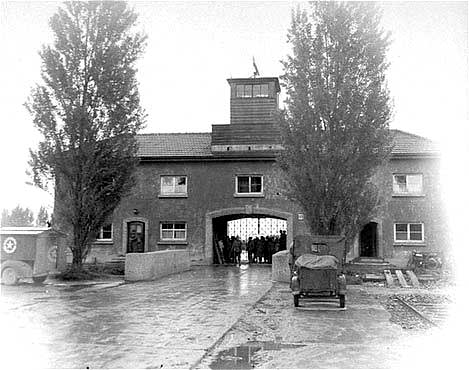 In his book, "Surrender of the Dachau Concentration Camp 29 April 1945," Col. John H. Linden wrote that the night before, on April 28th, "A combat unit of the Waffen-SS was sent to the Dachau Concentration Camp to surrender the camp to the first U.S. Army unit to reach the camp." According to Nerin E. Gun's book "The Day of the Americans," published in 1966, the Commander of the combat unit of Waffen-SS soldiers was Lt. Heinrich Skodzensky, although there are no SS records which mention his name. There is no mention of Skodzensky in the Dachau archives or in the Berlin Bundesarchiv. Abram Sachar gave this account of the surrender of the concentration camp in his book entitled "The Redemption of the Unwanted" published in 1983: Soon the advance scouts (of the 45th Division) were joined by other Allied soldiers and one of the German guards came forward to surrender with what he believed would be the usual military protocol. He emerged in full regalia, wearing all his decorations. He had only recently been billeted to Dachau from the Russian front. He saluted and barked "Heil Hitler". An American officer looked down and around at mounds of rotting corpses, at thousands of prisoners shrouded in their own filth. He hesitated only a moment, then spat in the Nazi's face, snapping "Schweinehund," before ordering him taken away. Moments later a shot rang out and the American officer was informed that there was no further need for protocol. This account refers to the execution of Lt. Heinrich Skodzensky, who had allegedly been put in charge of the SS garrison only recently, according to Nerin E. Gun, a survivor of Dachau. Skodzensky was allegedly executed by soldiers of the 45th Thunderbird Division who had arrived at the Dachau complex before the 42nd Rainbow Division. Contrary to Sacher's description of Lt. Skodzensky's execution, the concentration camp where "thousands of prisoners shrouded in their own filth" were being held was at least one kilometer from the area where the first executions of the Waffen-SS soldiers took place. According to Col. Buechner, who wrote a book called "The Hour of the Avenger," the SS garrison had a capacity of 1473 men. The guards of the concentration camp, who were SS-Totenkopf soldiers, were quartered at the SS garrison, along with Waffen-SS soldiers who had recently arrived from the front. The Waffen-SS soldiers were not responsible for the Dachau concentration camp, which was administrated by the SS-Totenkopfverbände, not by the Waffen-SS. Many of the guards had fled on the April 28th. Their wives and families had been left behind in the SS garrison. Whitlock wrote that one of the men of I company shot the handsome SS soldier, who had surrendered at the "big gate," because he tried to make a break to escape, after he had surrendered, according to Lt. Walsh. The name of this soldier is unknown. Then four more Waffen-SS soldiers emerged with their hands up and surrendered to the men of I company. Remembering the words of General Patton who had warned about dirty tricks, and knowing the evil reputation of the SS men, Lt. Walsh herded the SS soldiers into an empty railroad boxcar and "emptied his pistol" into them, according to Whitlock. Their bodies are shown in the photo above, as American soldiers were brought to the train to look at them. Lt. Walsh and his men continued through the SS garrison, rounding up the soldiers who had surrendered and separating the Waffen-SS soldiers from the Wehrmacht soldiers, who were in the regular German army. The photograph below shows some of the German soldiers who had surrendered.  Note the prisoners, who are assisting the American soldiers, in the photograph above, taken on April 29, 1945, the day of the liberation. On the right is a liberated prisoner wearing a pair of striped prison pants and a jacket with an X on the back. The X was painted on the civilian clothing worn by some of the prisoners to identify them in the event they escaped. The SS soldiers, who had surrendered, were lined up against a wall that formed part of a coal bin, as shown in the photograph at the top of this page. Lt. Walsh called for a machine gun to be set up facing the prisoners, and ordered his I company soldiers to shoot the Germans if they didn't stay back. When the SS soldiers saw the machine gun cocked and ready to fire, they panicked and started toward the American soldiers, according to John Lee of I company, as quoted by Whitlock. The medic who was present, Peter Galary, told Whitlock that he "refused to patch up the Germans we shot." ContinueExecution Account by Col. Howard A. BuechnerThe Killing of the guards in Tower BBack to Liberation of DachauBack to Table of ContentsHomeThis page was last updated on November 30, 2007 |